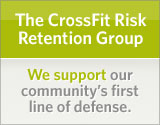I noticed several of you are starting to get banged up, especially during these last couple weeks with the Games and more dynamic WOD programming. You've been training hard and moving your body in ways it's never done before. But like your car, you need to do some preventive and reactive maintenance work to keep things running smoothly. If you choose to ignore these RECOVERY METHODS, you will probably end up injured or sick no matter how smart you train.
(Active) Rest
If it's a chronic overuse injury then full rest with no exercise is a valid option. But if it's an acute injury, we should be trying to work the area as soon as possible. This doesn't mean stopping exercise altogether, but rather taking the muscle, connective tissue, and joint(s_ through a SAFE range of motion that will promote blood flow and healing, In many cases, inactivity could hinder recovery b/c muscle fibers will not fire and reconnect or scar tissue formation will not reduce. In general, discomfort is acceptable, provided it is not making the condition worse. This could mean performing low intensity volume training, skill work, and/or flexibility/mobility training.
Ice & Ice Baths
Ice is your number one weapon when recovering from an injury. And while a bag of frozen peas is better than nothing (just don't plan on cooking those peas after they've been thawed, refrozen, then thawed again), there is a better way. Fill a styrofoam cup with water, freeze it, rip away the edge, and use it to actively massage the area. It penetrates deeper and promotes major blood flow to speed up recovery. It will also reduce swelling, inflammation, and pain. Ice for approx 10-15 minutes, let the area warm up on its own, and then repeat multiple times per day, every day, until you're 100%. Don't ice for just 3 minutes and then tell me you followed through with this protocol! Deal with the freeze. You won't feel it in 5 minutes. Ice after workouts - never before.
Ice baths are best immediately after a really punishing workout, when afterwards you think "Oh, man. This is gonna suck tomorrow." Fill a tub with cold water, throw in a few bags of ice, and jump in. Cover as much skin surface as possible (head included) for no more than 15 minutes. When you get out, let your body warm up on its own. This will stimulate glands and help speed up recovery between workouts. Just do an ice bath when no one is home so they won't hear all the crazy screams you'll make. Again, if you make to 5 minutes, you'll hardly feel it anymore.
Sleep
Arguably the most important recovery method - a good night's sleep. If you can get 8-9 hours (I definitely don't), then you're golden. When I trained for last year's games (we didn't do the Open format then),increasing my sleep was huge for my performance. Unfortunately, I don't get that much sleep anymore, and I'm sure many of don't get as much as you'd like. So we need to maximize the quality of sleep we can get within the time you have. Here are some quick tips to do that:
Keep the room on the cool side. Reduce caffeine and water intake approximately 6 hours before bed. Minimize alcohol consumption - 1-2 glasses of wine are OK, but any more will screw up your sleep cycle. And finally, get rid of all light in your bedroom. 100% darkness. No alarm clock, no cell phone, no TV, no nightlight in the hallway. Get black out curtains, no stars, no moon, no street lights. DARK. What a huge difference this makes!
Nutrition
Food is more powerful than any drug or supplement. Get your nutrition balanced on a consistent basis and you'll notice a huge difference. More strength, more speed, less soreness, and less dependency on medications. So what is the prescription? Lean meats & veggies, seeds & nuts, some fruit, little starch, and NO SUGAR,
Massage Therapy
By default, exercise causes micro trauma in our soft tissues. Over time this trauma leads to knots and scar tissue, causing excessive tightness in the muscle and unnecessary strain on tendons. This prevents the muscle from applying full power and also prevents the muscle from reaching full range of motion. Pushed to the limits it will result in injury such as inflammation or strains. A strain can be a simple overstretching of the muscle or tendon, partial tear, or full tear.
Regular massage therapy will remove adhesion and break down scar tissue, allowing for improved flexibility, power, and strength. It also creates higher body awareness (so you know when things are out of whack before you actually get injured), improves blood circulation, decreases inflammation, improves respiratory functions, stimulates the immune system, improves lymphatic movement to break up and release toxins, decreases stress and anxiety.
When I regularly visited a massage therapist in DC, my flexibility and WOD performance notably increased
Self Myofascial Release
But if you can't find that one awesome massage therapist (esp here in Korea), this method offers the same benefits as massage, to a lesser degree, but you can do it at home on your own. And you can do this more frequently.
The most common tools used are a foam roller, tennis ball, baseball, and lacrosse ball. We have foam rollers in the storage room, Just ask us how to use them and we'll demonstrate. We recommend using them before and after workouts on a daily basis. Personally, I also have tennis balls and lacrosse balls at home to use for my convenience, I even keep a lacrosse ball at my office desk and roll it on whatever hotspot I have, provided I don't make ass out of myself.
Here's a link to CrossFit Journal article trigger point therapy that covers the theory behind this method:
Hand Care (callous maintenance)
As we've seen the past few week, doing chinups and lifting barbells will get you callouses. This offers strength and protection when gripping heavy objects (gloves do not). Most people are initially grossed out, thinking callouses have to be big and bumpy and scratchy. Not true. In fact, a properly maintained callous will be flat and smooth. However, too much callous will cause pinching and that can lead to tearing and nasty looking pictures we see on Facebook :-). Here's how to avoid it:
- Use chalk while training. This reduces moisture in your hand so there's more friction between you and the bar. 100% friction equals no movement.
- After your training session wash your hands with hot water and soap to remove all the chalk. If you don't do this, your hands will dry out and crack.
- Use a good moisturizer.
- When you notice your callouses getting too big (if you can pinch them, they are too big), you'll need to flatten them. There are many ways to accomplish this, but the most common is to use a callous remover (looks like a mini cheese slicer/grater) after a hot shower. Make sure the callous is smooth and flat, but don't go too deep. Then lightly use a pumice stone as final touch to rid of loose skin.
If you ignore the advice above and happen to tear a callous, here's how you fix it.
- Wash your hands with hot water and soap.
- Cut away any torn skin with nail clippers.
- Soak in hot salt water multiple times per day and use a barrier like Burt's Bees Wax to protect the callous, keep it moist, and speed up healing.
- Cover the tear with athletic tape before training. Do NOT just wrap tape around your hand - there's a special method. Ask us a coach if you don't know how.
Well, a lot of info for sure. But try these technique outs and feel free to discuss them w/ me. -KenCFY











No comments:
Post a Comment